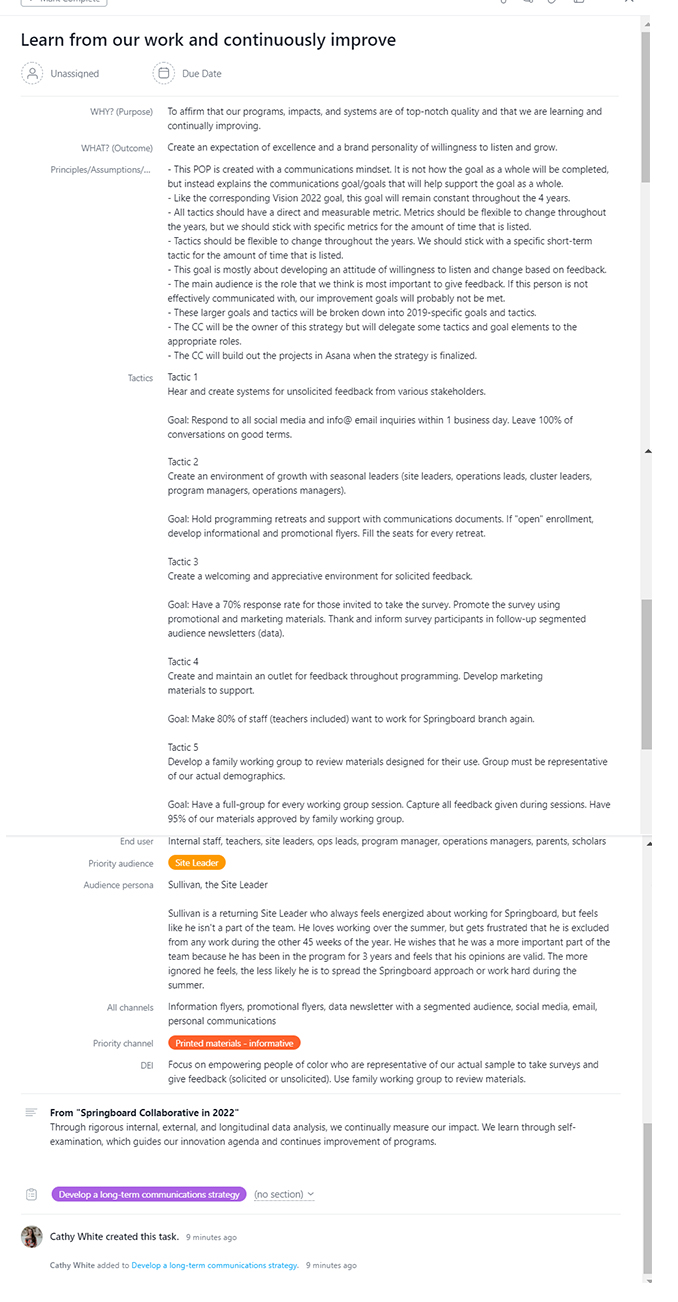When Cathy White shared with our Mentoring Program participants the collaborative process she went through to create her communications strategy, I knew other communications directors would be interested in hearing about it too. ~Kivi

Guest Post by Cathy White
I joined my organization, Springboard Collaborative, as the first communications professional they had ever hired. As such, I was tasked with creating a five-year communications strategy. It was an exhilarating and slightly overwhelming way to welcome me to the team and I had no time to waste.
I was lucky enough to work at an organization that had a five-year org-wide strategy to work from. I read through that strategy, adopted the six pillars that we are looking toward moving forward, and got to work.
Analyzing Each Pillar in the Strategic Plan
I felt too intimidated by the blinking cursor on a blank white page to open a Word doc and start writing, so I started by pre-writing. My first step was to really understand the pillars from a communications point of view instead of from an org-wide view. I took each pillar and dissected it further by filling out the following information:
- What the org-wide document describes the pillar as
- Why is this pillar important for communications?
- What does this pillar mean for communications?
- What principles and assumptions do I have about this pillar
- Tactics and corresponding goals
- All audiences
- Priority audience
- Audience persona for priority audiences
- All channels
- Priority channels
- DEI (diversity, equity, inclusion) considerations
I used Asana and a project with an insane amount of custom fields for this project, but a spreadsheet would work just as well. The main thing that I needed was to get away from the word processer and just let my thoughts flow in a different way.
Here’s one of the pillars in Asana . . .

From there, I copied and pasted that information into a Google Doc and invited a small group of people to comment, trying to get opinions from people who interact with different stakeholders.
I got a lot of feedback. A lot.
Digesting and Dealing with All of the Feedback
While at first, the comments stressed me out, I now realize how valuable it was to give an early draft to various team members, especially the ones I didn’t often connect with.
I gave myself some time to digest the feedback, blocking time on my calendar and squirreling myself away in a room with a whiteboard wall for an entire Friday. I wrote each pillar on the wall and wrote all the feedback on the wall, noticing trends.
During that antisocial Friday, I forced myself to open a Word document for the first time. (Even though I had already copied and pasted things into a Google doc, opening it in Word seemed like a new and frightening step.) After analyzing the feedback from each pillar, I started writing my new draft one pillar at a time, eschewing my categories and writing in standard prose, though some of the questions made their way into my second draft. By the end of that day, I had an almost complete second draft that was much better than the first.
Taking the Next Draft Back to the Teams
At this point, we had two major teams and I wanted to collaborate with both. One team was small enough (~5 members) that I could just use twenty minutes in a meeting to ask people to read over the draft and give their feedback right then to my face. This was also the team I was a part of, so we had a certain level of rapport.
The other team was large enough (~10 members) that I knew I would have to give something longer and more structured. For that team, I scheduled an hour-long meeting. Before we met, I organized team members into groups of three and set up a white board for pluses and deltas for each pillar. During the meeting, each group started at a different pillar and would get 8 minutes to read and discuss their pluses and deltas before they would move to the next pillar. After all groups cycled through the pillars, we met back up and debriefed quickly about what stood out most during the process, looking at the writing people had done during their 8-minute sessions.
Finally, this draft was reviewed individually by everyone who sat on our Leadership Team, which was a team of four.
Pulling Together a Final Draft
I had feedback from everyone in the organization. As a pleasant surprise, most of the feedback overlapped! I moved forward confidently into draft 3 with this collaborative feedback. Draft 3 only had to be approved by our CEO and our president, and I managed to get the strategy approved after a few very minor revisions.
I won’t lie – it was a lot of work. It was hard to set aside time to do proactive work when there was so much reactive work I could be doing. It was hard to plan ways to be collaborative. Sometimes, it was hard to listen to feedback on things I had spent hours (and hours and hours) of my life on.
But I feel confident knowing my direction and knowing that I will get buy-in from team members who helped me. When I have interns and new hires, I am articulate about our plans and our goals. I can prioritize. And I can always look forward.
Cathy White is the Communications Associate at Springboard Collaborative and a graduate of Nonprofit Marketing Guide’s Communications Director Mentoring Program. Cathy is passionate about reading, designing, and the Oxford comma.






